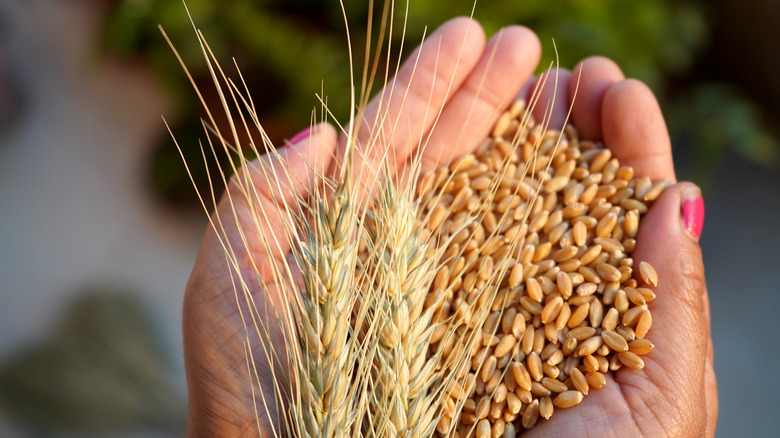The Underrated Breakfast Ingredient That Can Help You Lose Weight And Lower Blood Pressure
We may receive a commission on purchases made from links.
Are you on a mission to shed a few pounds? Is it time to tame your rising blood pressure? You may be able to do both by adding a simple ingredient to your morning meal: wheat germ.
Wait — germ? Yes, and it's a functional food source. The term actually comes from the fact that wheat germ is the part of the wheat plant that is used to germinate additional plants. (In other words, it's not a germ you need to avoid.)
In its raw form, wheat germ is bursting with nutrients. A single cup of wheat germ provides 15.2 grams of fiber and 26.7 grams of protein, according to information available from the U.S. Department of Agriculture (USDA). That's fairly substantial, given that the U.S. Food & Drug Administration recommends that adults aim to consume 28 grams of dietary fiber and 50 grams of protein per day. And it's those two nutritional elements that are most important for maintaining a healthier weight and warding off high blood pressure.
Wheat germ's fiber helps you lose weight, reduce blood pressure
To gain a deeper understanding of how wheat germ — and its fiber content — can affect overall nutrition, weight loss, and hypertension, Health Digest turned to Dr. Amy Lee, the head of nutrition for Nucific. Lee explained how wheat germ can work in your body's favor from both scientific and practical standpoints.
"Wheat germ contains higher levels of insoluble fiber," Lee said. "[W]ith added fiber into one's diet, we are talking about feeling more satiated and keeping one fuller longer. So that would help one not eat as much and implement some caloric deficit. Also, fiber helps with drawing out toxins and inflammation from the body which helps with cholesterol ... and even blood pressure."
Recent studies support Lee's explanations about the connection between fiber, body weight, and hypertension. For example, a 2023 study from Frontiers in Nutrition tracked the effects of a high-fiber diet on 4,477 subjects. After 16 weeks, 62.5% reported that they lost weight.
In another 2023 review from Cureus, the authors examined multiple studies on fiber and cardiovascular responses. They concluded that increases in fiber consumption seemed to correspond with decreases in blood pressure, although more research was advised.
These findings suggest that by boosting your intake of fiber, you can better manage or maintain your weight and blood pressure levels. And when you add protein into the mix, you get an extra advantage.
Wheat germ's protein helps you reduce hunger
As noted, wheat germ is high in protein. In experiments, protein consumption has been connected with higher satiety. And satiety means you feel less hungry after meals, allowing you to make healthier food choices. (Just say no to those empty calorie-filled vending machine temptations!)
A 2020 study from the Journal of Obesity & Metabolic Syndrome is a good example of the powerful effect of satiety. During the study, participants who were obese and ate high-protein diets saw a reduction in their weight. Plus, they seemed to be able to keep the weight off for at least six to 12 months.
Why does protein have this kind of effect? A Healthline article outlines the mechanism that makes this possible. Essentially, protein helps keep your hunger hormone from kicking in. Since the hunger hormone remains depressed, you feel fewer physical cravings — and aren't as likely to give in to a plate overflowing with sugary doughnuts.
How about mental cravings? Protein may be able to assist in that arena as well. In an older 2019 study from Nutrients, female obese subjects who were given protein (which was via a whey-based drink) experienced an anorexigenic reaction. Specifically, they felt less of a desire to eat within two-and-a-half hours after ingesting the protein-rich beverage. Consequently, you may want to test high-protein wheat germ as a possible daily food solution for keeping your hunger levels low so you're not as tempted to snack your way from breakfast to lunch.
Waking up to a wheat germ breakfast
What's the takeaway here? As Lee noted, wheat germ is beneficial. Additionally, it's a food with a pleasant taste profile that features (in its raw, not powdered form) a crunchy texture, nutty flavor, and natural sweetness.
However, you may be uncertain how to bring it into your breakfast foods. One way is to simply mix the powdered version with homemade smoothies or even cooked cereals. Though you won't get any of its natural texture or as much of its taste that way, you can still tap into its nutritional value if you buy a high-quality wheat germ powder. (Note: You can get wheat germ as an extract or oil for use as a non-culinary diet supplement.)
Of course, purchasing wheat germ in a dried, crunchier form like the highly rated Kretschmer Wheat Germ Honey Crunch on Amazon opens the door to plenty of meal possibilities. As a dried product, it can be used as a quick topping. It can also be incorporated into breakfast bread doughs. When all else fails, you can even purchase Kretschmer's "Naturally Good Wheat Germ Cookbook" to give you more ways to make wheat germ part of your day.
With that said, you should always be careful if you have an existing wheat allergy or sensitivity. WebMD indicates that people who can't tolerate wheat probably won't be able to tolerate wheat germ. Therefore, take note if you experience congestion, stomach upset, hives, a rash, or respiratory issues after trying wheat germ. WebMD identifies all those reactions as hallmarks of a wheat allergy.



